In-house Marketing - The Ultimate Guide
- Start
- Resources
- Ultimate guides
- In-house Marketing
What is in-house marketing?

In-house marketing is far from a passing trend. The value it is providing international brands across a range of sectors, is proving that in-housing is here to stay.
The exact benefits of in-housing marketing functions vary from market to market, and even business to business, but key areas of value that many organisations come back to are:
- Increased transparency
- Cost-saving
- Greater agility
- Greater control over brand messaging
- Greater control over creativity
There are other benefits of in-house marketing too, such as higher ROI and increased creativity.
Exactly how in-housing is done varies. From hybrid models to fully-fledged digital teams. We suggest exploring what the options are and thinking about what would work best for your team.
The definition of in-house marketing

In broad terms, in-house is defined as any work that’s done within an organisation or business by its employees rather than by external people.
There is also no one-size-fits-all approach when it comes to in-housing. Every business must identify what competences are available internally and what functions are required to perform marketing efforts at the level they wish to.
With that in mind, our research identifies three main in-house models: The Hybrid, The Full Digital Competency and The Traditional set-up. However, as mentioned, there are many more variations of in-house models, each with different ways of working with external and internal resources.
You can read the latest stats about the three main models in our annual in-house marketing report: The State of In-housing 2022.
A brief history of in-house marketing

The term “in-housing” is a recent addition to marketing vocabulary, however, the concept of in-house marketing is nothing new. Neither are the advantages and disadvantages of bringing marketing functions in-house. Indeed, the arguments have been pretty much the same for about a hundred years, with reducing costs as one of the key motivations.
Moreover, since the 1930s, in-housing has been a cyclical phenomenon, with many big brands shifting back and forth between using external agencies and keeping marketing in-house.
But then everything changed in in-house marketing…
The Great Recession of 2007-2009 became the trigger for the adoption of modern in-housing on a much larger scale. Indeed, when The Association of National Advertisers conducted its first in-depth survey on US in-house agencies in 2008, 42% of marketers reported they now had some form of in-house agency.
During the 2010s in-housing started seemingly taking root permanently thanks to digitalisation and advances in technology.
Furthermore, a greater understanding of martech has seen the requirement of greater transparency over decisions too. Procter and Gamble’s, Marc Pritchard’s landmark speech set the tone regarding industry resentment over how some agencies had taken advantage of business’ apparent lack of tech knowhow.
“As digital media became dominant, we faced the inconvenient truth that we were operating in a murky, nontransparent and sometimes even fraudulent media supply chain.”
Marc Pritchard, Procter & Gamble Chief Brand Officer
Indeed, today even a small in-house team can perform marketing functions that previously would have been outsourced thanks to technology. In fact, marketing is evolving at a pace never seen before, with many new roles now needed to win consumers and lift businesses. Being able to acquire and maintain a skilled in-house workforce is now a key requirement of even the most basic marketing teams.
At the same time, it doesn’t mean agencies are a thing of the past. It simply means the relationship between brands and agencies is evolving, just as the market does.
What are the consequences of working in-house?

When deciding whether to work in-house or use an agency, there are various factors to consider. We cover the majority on this page, but during this specific section, we want to look closer into how in-housing affects employees as well as the company in everyday life.
Naturally, what affects employees affects the company, and vice versa. Still, on a daily basis, the effects of in-housing marketing will definitely be perceived differently if you ask the CEO, the CMO, or a designer.
What is the difference between working in-house vs using an agency?
To answer that question, we will look into some of the changes in-housing will bring for an employee, followed by the company.
How in-housing affects employees:
From client, to operational
In-housing means becoming less of a client telling others what to do, and more of someone doing it yourself
Increased speed
Suddenly, everything can happen when you want it to – say goodbye to lengthy lead times.
Also, since everyone is speaking the same corporate language, and oftentimes sitting under the same roof, smooth collaboration will increase speed, as well.
Increased transparency
When making the shift to in-house, you can get a better understanding of spend as well as data. This equals new opportunities to make more informed decisions. Paired with already existing in-depth brand, culture, and product/service knowledge, this can definitely improve results.
New team members
With in-housing comes new employees! Building a new, strong, in-house team can be a really fun experience.
How in-housing affects companies:
Lower costs
Agency costs can be pretty high. Sometimes, that investment pays off. Sometimes, it doesn’t. Either way, in-housing means removing that cost – either completely, or partly.
Of course, in-housing means initial investments. Although, in the long run, many brands more than make up for this.
Increased return on investment (ROI)
With reduced costs as well as increased work speed and transparency, a positive effect on ROI will most likely follow.
The increased ROI can be used either to continue expanding the in-house team, or for other investments that are deemed strong.
Increased control
With the in-house team getting access to even more data, they can better display what is performing, and what is not. That goes from detailed knowledge about a certain product, to how the team, as well as the company, is performing. In itself, that means increased control of the company.
New employees
Make sure your marketing team has mapped out what their needs are, and that you are ready to recruit. Help prepare the marketing team, so they are ready to welcome their new team members.
The State of In-housing 2022
Fill out the form and gain exclusive insight into the in-house marketing trends you need to know for 2022.
How much does in-house marketing cost a company?

All in-house set-ups look different, meaning costs related to in-housing is a complex question. There is of course a big difference in cost savings between a company that has only in-house digital marketing production and a company that also has in-house creatives, social media buying, and such.
In other words, the size of the team matters. Starting small and building the case and costs over time when the business value is shown, is probably the safest bet. Once it is done the right way, in-housing can be a very smart decision, financially. Below are the stats from Bannerflow’s 2021 in-housing report:
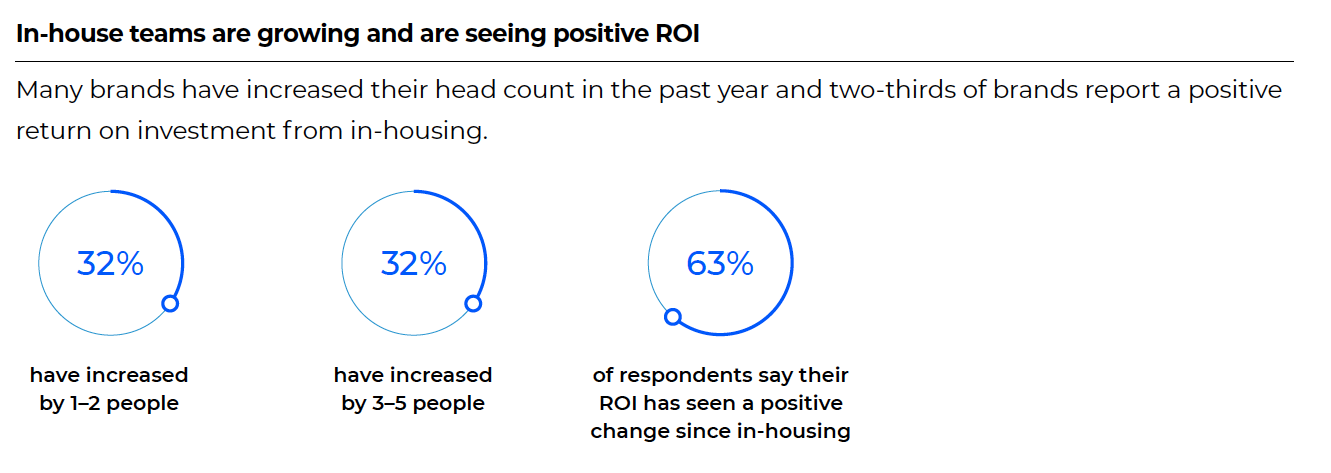
Evidently, data shows a strong correlation between in-housing and increased ROI. In-housing gives a competitive advantage to react more quickly to marketing trends as well as it increases control over data. Speed and access to data is proving to be a booster for ROI.
“Social media isn’t going away. By bringing that work in-house, it helps us build out digital specialisms internally to ensure we’re establishing a road map of digital excellence. It makes sense to be able to foster that creativity and that digital skillset internally, because as we continue to grow and as our business becomes more digital, it helps to have those people in-house.”
Matt Risley, Head of 4Studio
Why are brands taking more marketing functions in-house?

Making the switch to in-house can have many benefits, but an important factor for many marketing departments is the increased control. This applies to many areas, such as:
- Transparency
- Costs
- Data usage
- Agility
- Brand consistency and creativity
1. In-house brings transparency
Transparency is an important topic for the whole industry. Especially since 2020, when a report from trade body ISBA revealed that nearly half (49%) of ad buys evaporated before reaching publishers. By moving marketing in-house, you get an understanding of where exactly your money is being spent, by taking control of your programmatic media buying and optimising for the greatest return on investment (ROI).
Transparency applies to time, too. In the 2021 Bannerflow State of In-housing report, 59% said in-housing will improve agency transparency. This entails knowledge and understanding of the time it takes to complete marketing functions. As an example, producing display advertising should take days rather than weeks.
2. Costs
Saving money is always a great advantage, and one of the greatest that in-housing enables. Doing some marketing functions in-house will most likely help cutting costs, especially along with the knowledge and control over exactly where and how your money is being spent.
Developing competencies and new skill sets in-house, such as media buying, can also save budget in the long run. Or, it can be a great opportunity to reallocate budget. Our 2020 survey shows that 65 percent of those respondents who increased their head count by 3–5 people have also decreased their agency spend — suggesting a reallocation there of in-house expenditure and a correlating reduction in resources spent outside the organisation.
3. Data usage
It’s no secret that marketing departments hold a lot of data. Keeping that data in-house is a great way to make sure it’s secure, as well as it enables marketing departments to act upon it instantly. As a result, building competency to understand and work with that data internally becomes both crucial and very valuable.
4. Agility of in-house marketing
No one likes lengthy lead times. Simply tapping your colleague’s shoulder and asking them when they will be done with their work, or keeping all assets in one collaborative platform, definitely improves workflow and collaboration.
Additionally, changing assets can be done quickly. Whether that is making a small adjustment, or creating something completely new as a reaction to the market or a competitor, increased speed and agility can make all the difference.
5. Brand consistency and creativity
Another benefit of in-house teams is they make it easier to keep your brand aligned, even at the micro level. From a single ad to a full scale, global campaign – keeping all the production in-house is a great way to ensure brand consistency.
Apart from the improved control over areas such as those mentioned above, data shows increased ROI and boosted creativity levels are two other main reasons companies bring their marketing in-house.
What are the advantages and disadvantages of in-house marketing?

As with anything, there are pros and cons to in-house marketing. These are the most common ones that brands come across:
Advantages of in-house marketing:
- Increased transparency
- Cost-saving
- Greater agility
- Greater control over brand messaging
- Greater control over creativity
Disadvantages of in-house marketing:
- Lack of talent and skills
- Requires creativity
- Time to develop skills
How great the advantages (as well as disadvantages) are depends on the team: What competencies are already available prior to in-housing? How motivated are your staff? How well prepared is the department and organisation for change? Those questions all affect outcomes.
What is the relationship between in-house marketing and creativity?

Benefits of in-house marketing teams and creativity
Creativity is a key component within marketing. Creating content your audience will engage with is essential to get results in an oversaturated market, when expressions such as banner blindness are established. For that reason, lack of creativity may be a concern when moving marketing efforts in-house. Although, when asking marketers in our State of In-housing 2021 report, 56% percent of brands actually perceive themselves as more creative since in-housing, where the main reason is they have become more curious.
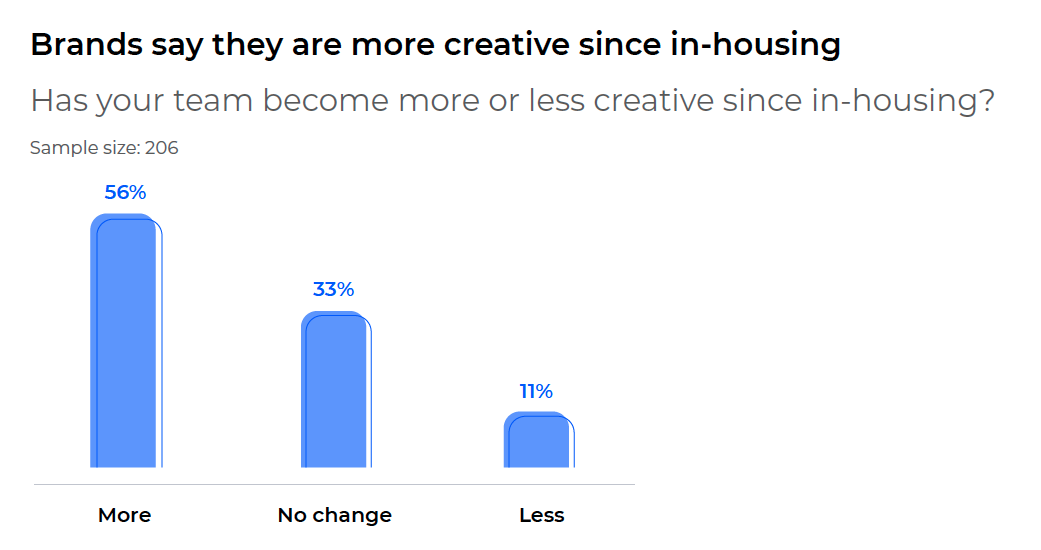
To say that in-house marketing will solve all those concerns is to simplify, but it sure can help. Data speaks for itself. With that being said, some marketers still perceive impediments when speaking of in-housing, in regards to creativity. Our report shows that barriers to creativity include organisational structure (44 percent), lack of technology (44 percent) and lack of time (43 percent). Other concerns may be lack of skills/talent and high costs. If these impediments are relevant to your organisation, you might find the perspectives below intriguing.
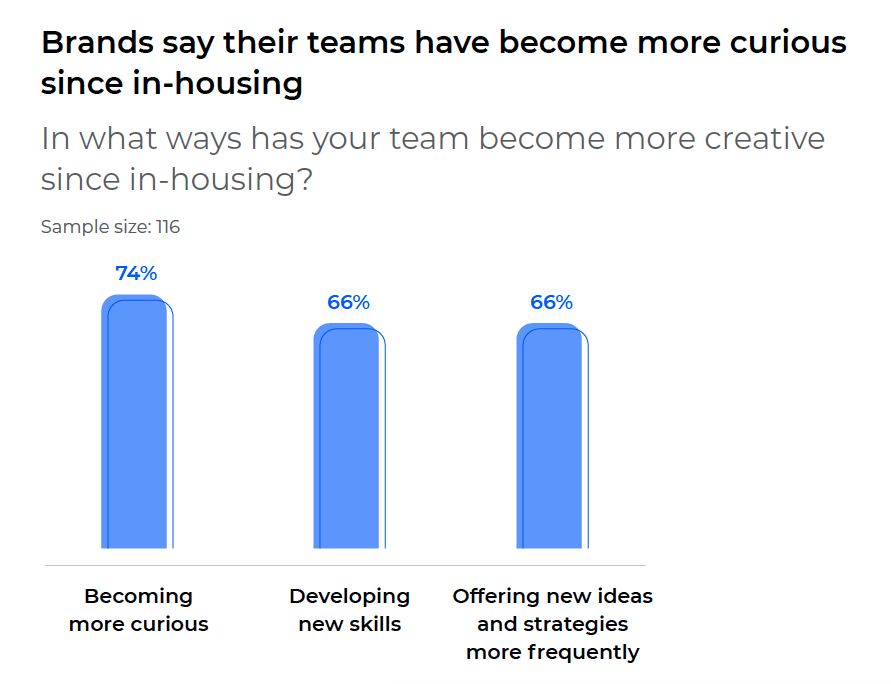
Problem 1: Lack of time
Many companies choose to outsource all or parts of their marketing efforts due to lack of time. Therefore, to say that bringing them in-house will save time, might seem foreign. Still, with the right team and the right tools, in-house marketing can definitely save you time. For one, working in-house means you have all the product as well as company knowledge within reach. Compared to working with an external agency, that can definitely speed up production. Overall, it is a lot easier to improve workflows and collaboration when everyone is under the same roof – or working in the same, cloud-based platform.
That brings us to the next subject – having the tools and technologies that enable productivity. For example, by using a creative management platform, you can forget about repetitive tasks such as scaling or translating, and having AI do it for you. That way, you can produce more in less time, and have designers focus on actually designing. The perfect way to increase creativity levels!
Also, saving time is not only about actual hours, but also about saving calendar time. In many markets, having the ability to react to competitor offers and cut lengthy lead times is invaluable. Reaching that speed can be difficult when you are not working in-house.
“If you work with an external agency, they deal with a lot of urgent requests from many different clients. We only focus on one client and that’s Kindred Group. I don’t see how we could work with an external agency.”
Max Taub, Head of Acquisition Optimisation, Kindred Group
Problem 2: Lack of skills/talent
There is no secret it takes time to build a great team – no matter what team that is. The challenge with finding the right skills and or talent goes for in-house teams as well. In fact, it is being stated as one of the top perceived barriers to in-housing. The skills marketers are missing in their in-house teams are digital marketing knowledge, creative thinking and organisational skills.
However, we can see that the challenge with finding talents has gone down from the 2019 report to the 2020 report. This is a sign that in-house teams are becoming more mature, better at understanding what types of skills they need, as well as knowing how to keep talents by creating a strong culture.
When in-housing, a great reminder is also that no team looks the same. For some, a complete in-house team works the best. For others, a hybrid solution where some marketing activities are done in-house, and some via an agency, is a better option.
Problem 3: High costs of in-housing
Any change in an organisation may entail costs, which is why in-housing may seem intimidating. However, one benefit often mentioned when talking about in-house marketing is increased control across several areas. That can refer to data usage, production, budget, and more, which can result in increased ROI. Our report shows that as many as 63% of respondents say their ROI has seen a positive change since in-housing.
Swedish betting giant ATG is a good example of how in-housing means gaining control not only over campaigns, but all assets available at the company. By using leftover video footage from a big commercial shoot from the previous year, the ATG in-house team managed to show another side of horse-racing. As a result, they created an emotive campaign that led to ATG winning Bannerflow’s quarterly Best display advertising campaign 2020 – without even having to produce new material. This shows how in-housing can increase proactivity as well as creativity, while decreasing cost.
“I think this is one of the strengths of being an in-house agency – we have a good overview of the productions, both external and internal.”
Mattias Hallbom, Senior Designer/Creative Lead, ATG
Problem 4: Organisational structure
Changing an organisation can definitely be a challenge. One way of getting there could be by starting to build trust in how in-housing can help businesses reach their goals. Showing success stories and research that indicate that in-housing is the future, can be reassuring.
Do you need help putting into words what in-housing can look like and how it can benefit your company? Let our most recent state of In-housing 2022 report do it for you.
Also, sharing that in-housing doesn’t necessarily mean not working with agencies at all, might be an idea. Moving some marketing activities in-house while still outsourcing some can be a good way of transitioning to in-house. Make the shift at a pace that fits the organisation.
Problem 5: Lack of technology
Technology is important to marketers as it, among other things, allows them to focus on the creative aspects of the job. Not only can it enable innovation and reduce manual tasks, but it’s also a great way to increase collaboration. Our data shows technology has been an enabler for in-house teams: 55 percent say creativity levels have been boosted, and 54 percent are seeing more collaboration as a direct result. In other words, no wonder having the right technology in place is key for marketers. If you are wondering what technology that entails, find our section on having the right martech software stack.
Why develop KPIs for creativity and in-house teams?
KPIs are a natural part of most, if not all, organisations. Yet, some teams do not yet have KPIs for creativity, but more and more organisations are getting there. In our 2020 report, data shows that almost half of marketers have defined KPIs for creativity and another 48% have started to experiment with different KPIs for measuring creativity.
When using external resources, setting a KPI for creativity can be challenging. You might not have the same insights into neither the work process behind the material, nor the results it generates. By in-housing, setting and following up on KPIs becomes a lot easier – meaning increasing ROI does, as well.
Accurate measurement is key
One way of doing that is making sure you measure the right KPIs. That can be a challenge in itself. An idea on how to measure KPIs for creativity can be by combining ad-recall, ad-liking and campaign efficiency. With that being said, that might not be the most efficient way to measure creativity for your organisation.
No matter what the KPIs are, try to integrate them in your everyday work. This can be done by using the right technology, such as a creative management platform, since it allows you to see results in real-time. That creates opportunities to optimise campaigns and improve the chances for an in-house team to actually hit those KPIs – and even perform beyond them.
What are the most common barriers to in-housing marketing functions?
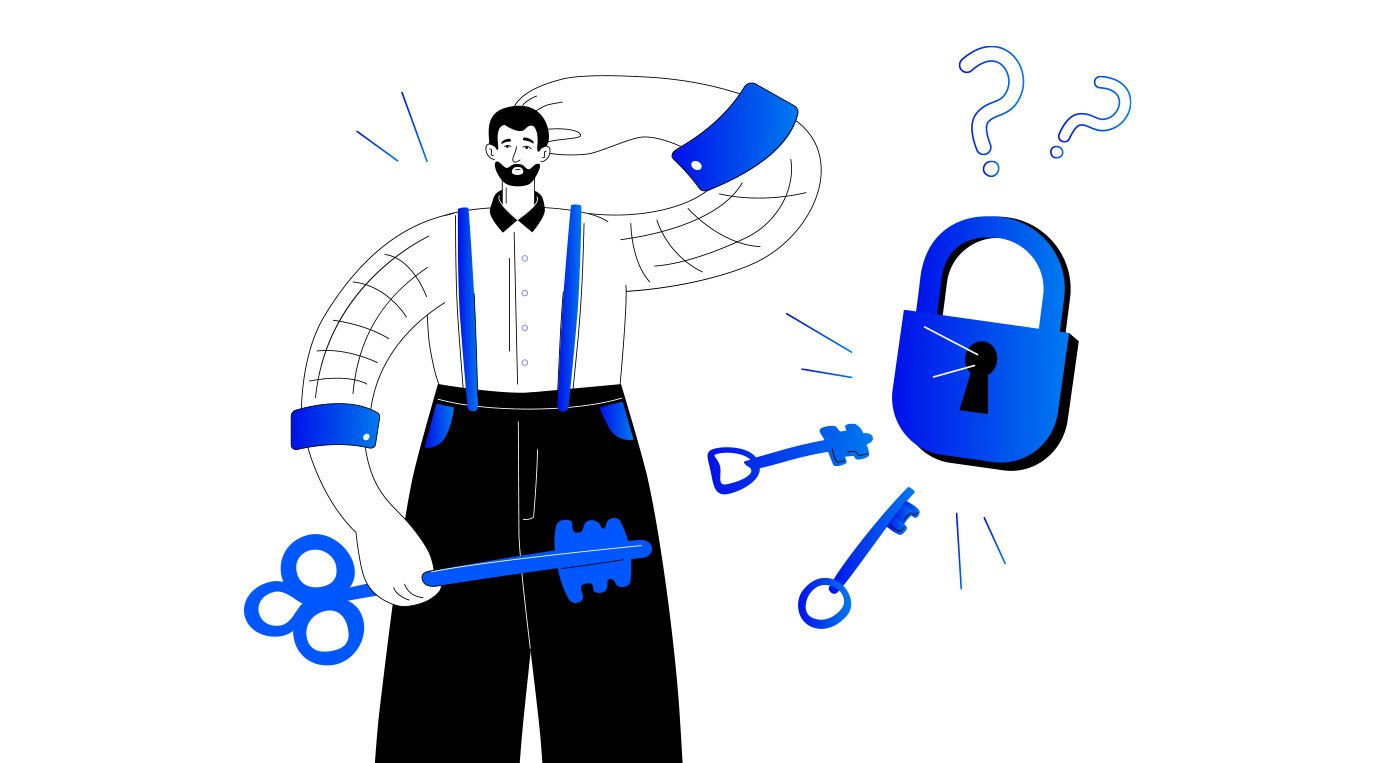
Bringing marketing in-house can seem like a big step. Depending on the business as well as individual team members, different concerns may arise. During our 2021 in-house study, we found that the following were the top three barriers for brands to in-house:
- Communicating the purpose of in-housing and gaining buy-in internally
- Lack of knowledge around buying programmatically
- Lack of funding to build a competent in-house team
When comparing the answers from teams that have in-housed within the past 12 months, to teams that have in-housed for more than a year, the barriers shifted slightly. While older teams face challenges in finding specific programmatic knowledge, younger teams have trouble communicating the purpose of in-housing. For more in-depth information on these barriers and how to overcome them, download our report State of In-housing 2022.
It’s also worth noting what these teams said are the benefits of in-housing. Data shows these are the top three reasons for all brands to in-house:
- Efficiency of production
- Time and attention given to brand
- Greater control over brand messaging
Just as with the barriers, the ranking of the benefits do shift slightly depending on how long the team has operated. For newer in-house teams efficiency of production is the biggest benefit, while for older teams it is greater control over messaging.
These benefits can outweigh some of the challenges that brands are experiencing. If you want more benefits of in-housing, see our section “Why are brands taking more marketing functions in-house?”
When should you bring your marketing functions in-house?

All companies are different, meaning the in-house set up will look different, with focus on different competences. Before that question can be answered, you need to know if you would benefit from in-housing everything, or just some activities.
Therefore, you need to start by mapping all marketing needs, categorize them and start benchmarking pros and cons between doing it in-house or with external support. This all depends on the specific needs within your organisation and the industry you are in.
Also, remember that going in-house is not black or white. You can bring something small in-house to start with, for example social media or content creation. These might also be a good starting point since they are areas that may require higher speed and flexibility than external agencies can give you. For more inspiration, see what other brands have brought or are planning to bring in-house.
What are the different types of models and structures of in-house marketing?

Full digital competency
Hybrid model
Traditional model
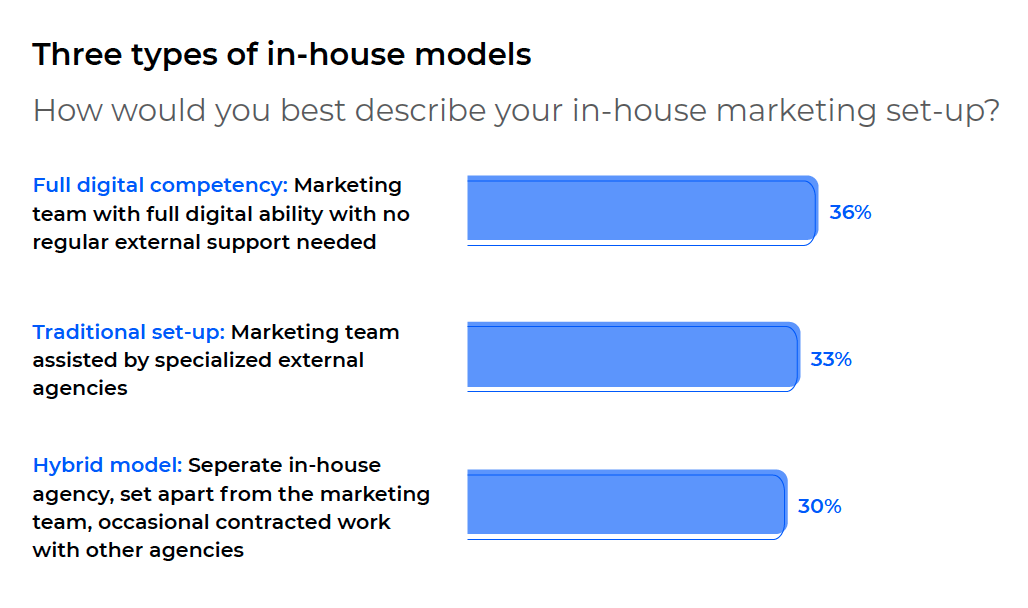
In-house agency
A full scale agency team with designers, developers, and marketers, residing in-house.
Bespoke agency
A traditional agency which is based permanently within the marketing team of a brand.
Figuring out which model works best for your team can be a challenge. If you are currently relying a lot on external agencies, becoming a full digital competency in-house department won’t happen overnight. Changing an organisation takes time. However, studies show that slowly but steady, more brands are indeed moving towards in-housing.
How are some agencies and in-house marketing teams working together?
Agency and brand relationship is evolving, where a new age of digital transformation agencies and specialist consultancy firms are now helping brands through their in-house journey.
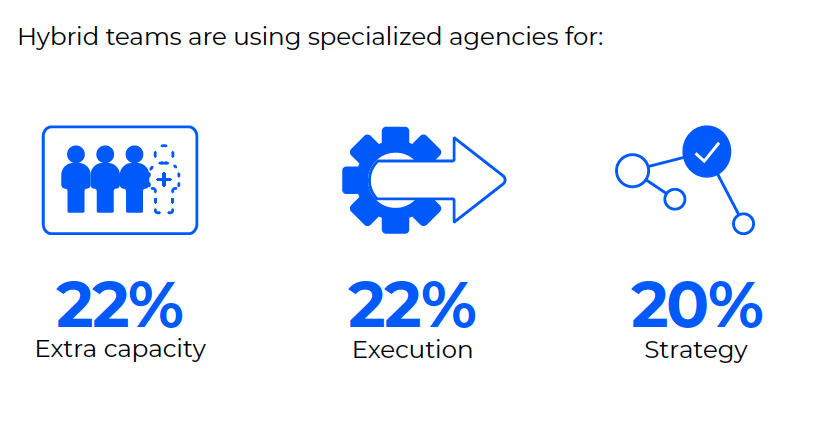
Instead of asking an agency to help with producing a graphic element or providing copy, in-house marketing teams may come to agencies with questions such as “how do we digitalise our product?”, “how do we grow when launching on a new market?”, or “how do we get this specific product to sell to this specific audience?”.
Also, getting a fresh pair of eyes (or several pairs!) on what you are doing is always beneficial. Even complete in-house marketing teams can still use creative agencies for concepts and specific skills, to raise their creativity and performance to the next level. As an example, our report also shows that 30 percent of brands are using a hybrid model. When asking these teams what they look for in their partners, they answered:
- Extra capacity (22 percent)
- Execution (22 percent)
- Strategy (20 percent)
- Niche expertise (19 percent)
- New ideas (17 percent)
As the answers vary, one conclusion may be that flexibility is at the top of the list when in-house teams turn to agencies.
What are the different roles required for an in-house marketing team?

Creating an in-house team takes time and money to set-up. Yet, many find that the results outweigh the initial investment. Total transparency and control of marketing activities makes it worth it.
As a result, many brands are slowly building in-house teams. There are even recruitment agencies offering specialist services to help put together the perfect team. Now, what does that consist of? That is a question many marketers seem to ask, since a lack of talent and skills ranked within the top three barriers to in-housing. Find out more through our webinar on building an internal marketing department or continue reading below.
Evidently, the answer to what putting together a perfect in-house team means, is not standardised. It will all depend on what your business size and needs are. It is clear that more and more brands are moving more specialised roles in-house, but how many and which ones will vary. In some cases, every role will have a dedicated team. In others, one person has to handle several roles.
Nevertheless, below are some key functions to any effective marketing team:
- Content
- Design
- Digital specialist
- Paid marketing
- Analytics and SEO
- Social media
- Media buyer specialist
- CMO
Content
When hiring a content team, keep in mind:
– What content does your personas respond to?
– What are their pains and how can you solve them?
– How can you shape content accordingly?
Look for someone who is:
– Creative
– Efficient and engaging
– Bonus – extensively experienced within SEO
Design
When hiring a design team, try this:
– Give potential hires a test project with a time limit, and compare work
Look for someone who has:
– The ability to work well under pressure
– Extensive tech stack capabilities
– Bonus – industry experience
Digital Specialist
When hiring a digital specialist team, keep in mind:
– They can be key drivers in shaping the marketing team’s priorities – make sure it is a thought leader
Look for someone who has:
– Considerable experience
– Exposure to search and performance KPIs
– Extensive understanding of your tech stack
Paid Marketing
When hiring a paid marketing team, keep in mind:
– Algorithms constantly change, you need someone hungry
Look for someone who is:
– Data-driven
– Innovative and creative
– Channel as well as industry experienced
Analytics and SEO
When hiring a digital specialist, keep in mind:
– The ultimate candidate is someone who understands numbers as well as people
Look for someone who has:
– Proven track record with SEO
– A well-rounded understanding of marketing
– Great analytics skills
Social media
When hiring a social media team, keep in mind:
– Social media is just as important as Google search – make it a priority
Look for someone who has:
– Great imagination
– Considerable experience
– Worked across platforms
Media Buyer specialist
When hiring a media buyer specialist, keep in mind:
– It is a specialised role – let someone experienced do it
Look for someone who is:
– Up to date with strategies for greater ROI
– Strategic as well as operational
– Experienced in the right technology
CMO
When hiring a CMO, keep in mind:
– Hire someone who knows far more about marketing than you do!
Look for someone who can:
– Be a chief strategist, coordinator, and team leader
– Understand the different expertises of their team
– Challenge you and their team to be better and succeed
Interested in finding out more about putting together a great in-house marketing team? Read our blog post about it.
What are the different skills required for effective in-house marketing?
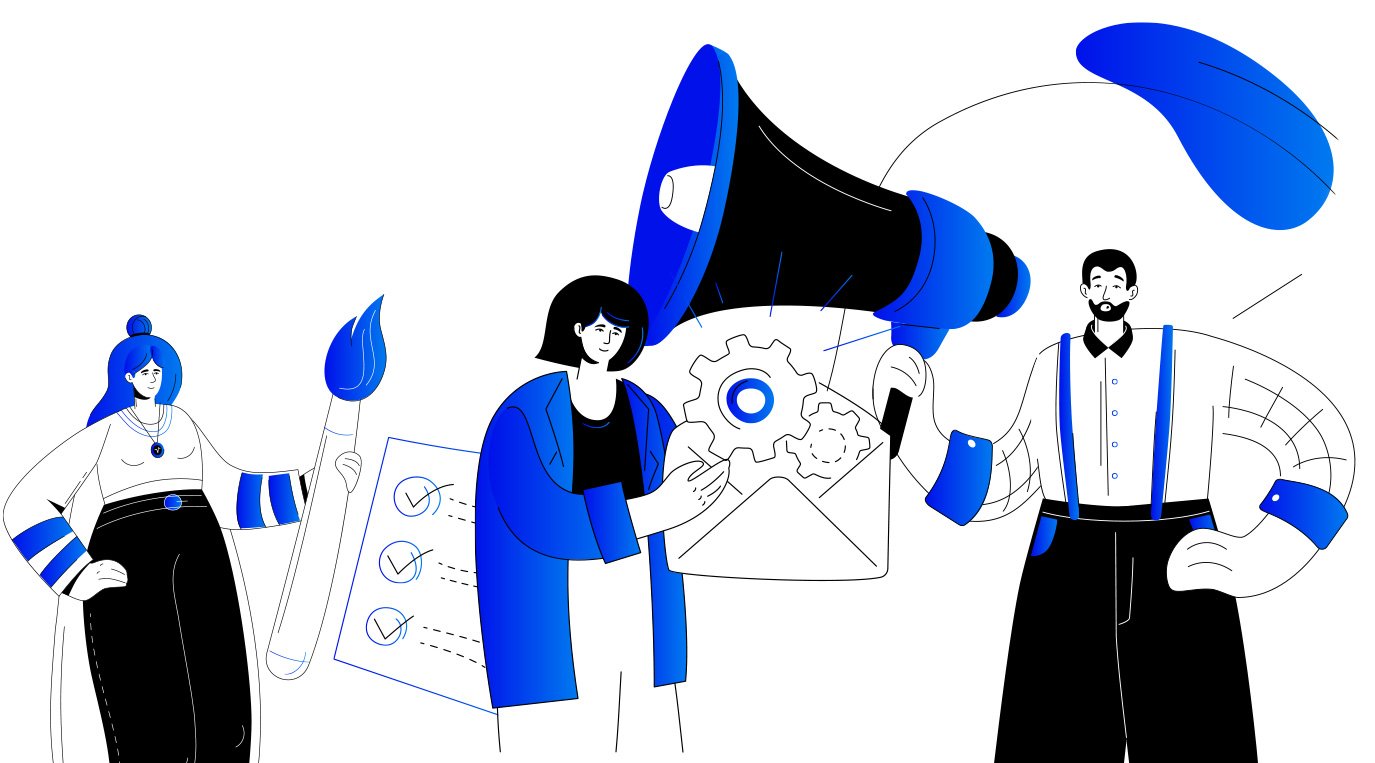
What are the most common skills brought in-house?
According to our 2021 in-housing report, content creation tops the list of skills brands have moved in-house. Additionally, roughly 55% of teams have also moved media buying and design in-house, followed closely by social media and paid search.
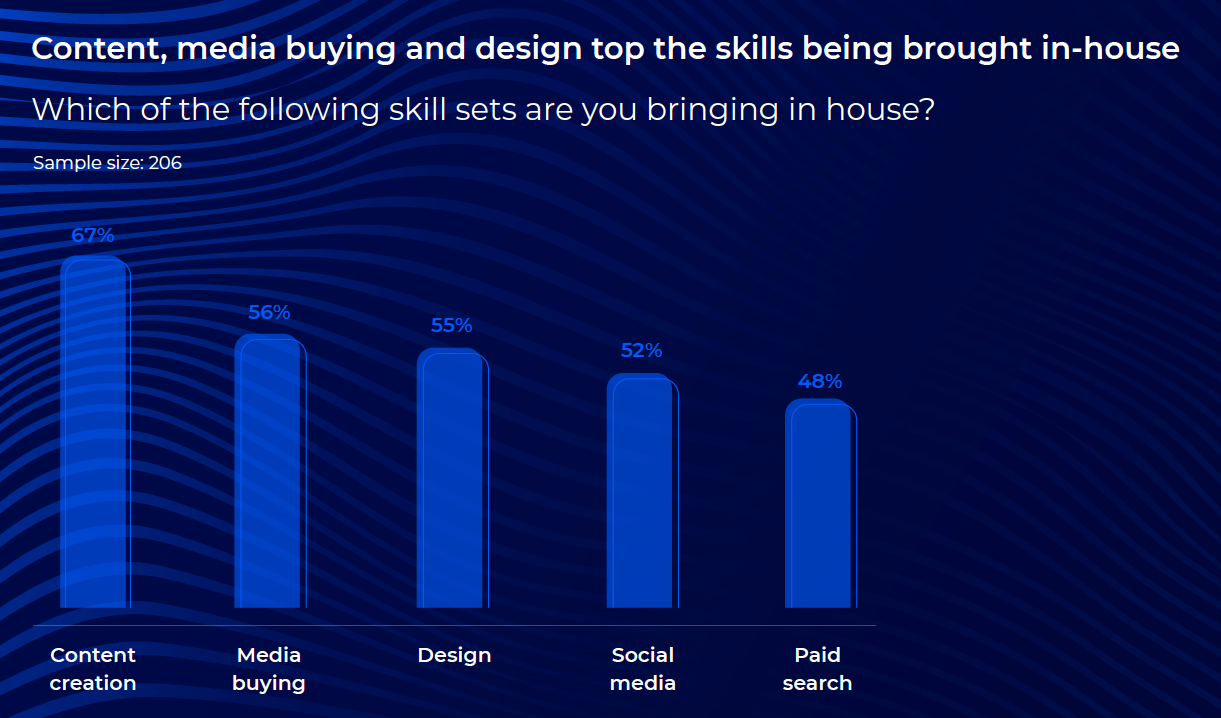
With that being said, in-housing gives you a great opportunity to really pinpoint what skills your company needs. Dries Mertens, director of DraftLine Europe — AB InBev’s In-house Agency —, gives the following advice to any company that is building an in-house team: “Don’t try to recreate an external agency. With an in-house agency, you have the freedom to do things differently — to question the whys, to think about different ways of putting pieces together, to consider different processes that can run different types of work output.”

Regarding team size, 62% of those who have teams of 6–10 people increased their head count by 1–2 members, while 55% of those who have teams between 11–20 experienced no increase or decrease to their head count. This may indicate that 11–20 people might be an optimum number for an in-house team. When looking at smaller teams, 56% have seen a decrease by 1–2 people — which could be due to smaller teams experiencing the negative effects of COVID-19.
In-house marketing and the pandemic
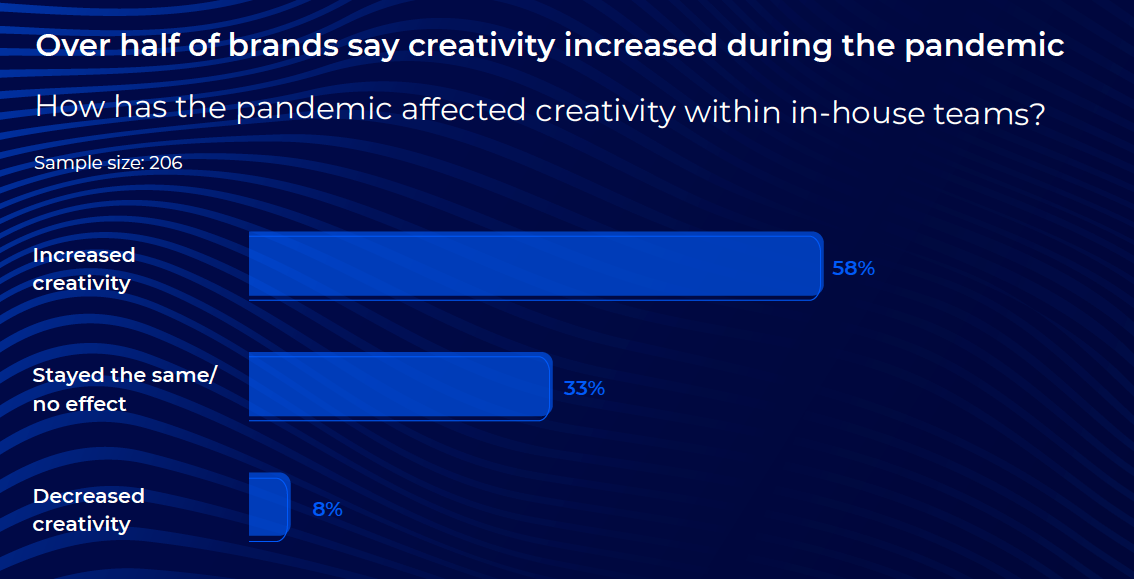
To stay creative during the pandemic, in-house teams have incorporated different methods, such as workshops, cross team collaboration, and collaboration technology. The top three aspects of in-housing that have enabled teams to stay creative during the pandemic are as follows:
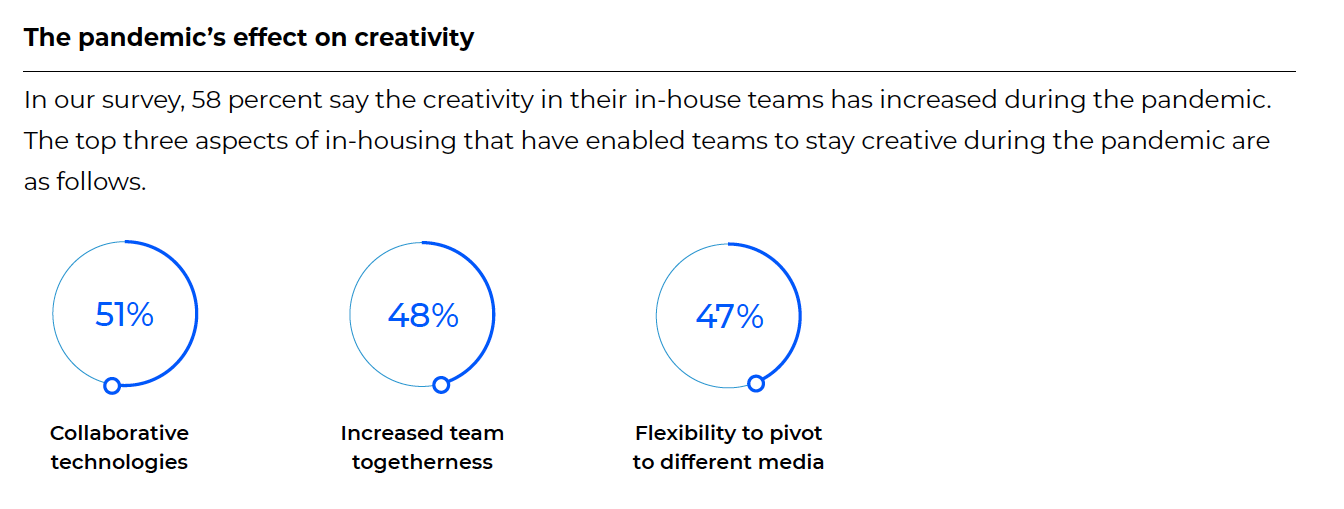
“I believe that the global pandemic — in fact — significantly boosted our creativity as we started to invent many new activities, campaigns, features or even whole products which helped our customers to survive in better (physical or mental) shape. It forced us to go the ‘extra mile’ as at the same time, we also supported our usual business goals.”
Michal Mironov, Online Marketing Manager at O2 Slovakia
How does technology impact in-house marketing
Having the right martech stack is essential for getting the most out of in-house marketing. Here are four key areas where technology can play a big role in boosting your results:
1. Better use of data
Accessing and using data might be the biggest game-changer that digital marketing brings compared to traditional marketing. Measuring exactly what your audience wants, and how your campaigns are performing, can have massive impact on your marketing results. That is, if you know how to use that data.
Make sure you have access to a platform that lets you view data and easily optimise your campaigns based on it. For example, having the possibility to update live campaigns, A/B test, and use heat maps, enables you to actually utilise insights and increase performance.
2. Greater collaboration
Tired of having five on-going conversations about the same campaign at once? Stop concepting in one place, commenting in another, and approving in a third. By using technology that allows you to go from idea to published campaign in the same tool, you never have to worry about overlooking feedback or missing to approve something.
Even better, if your martech of choice is cloud-based, that means work can happen anywhere, at any time. For a global, or even regional, cooperation, that is key.
3. More efficient workflows
By keeping all of the campaign production in one platform, not only does collaboration improve, but so does workflows. When in-house marketing is added to that mixture, that means no more lengthy lead times or similar obstacles.
4. Boosted levels of creativity
Lack of time and high costs are two essential pain points when it comes to creativity. Technology is perfect for getting rid of those. By removing repetitive tasks such as scaling and translating, designers will get more time to actually design. This can bring creativity to a whole new level. At the same time, it cut costs by enabling increased productivity, hence more ad variations to test.
What is the perfect in-house martech software stack?

Martech needed for off-site campaigns
- Scaling ad production across channels
- Optimising programmatic campaigns
- Boosting creativity and personalisation
- Combine all of a company’s first party data in one solution
- Create an understanding of exactly where and how to spend funds
Needed to:
- Buy online advertising programmatically, at scale
- Buy, serve, and track ads in one centralised place
- Optimise ads easily
Martech needed for on-site customer communication
- Consolidate, sort, and segment audiences
- Keep track of how and when leads are moving through the marketing funnel
- Interact with leads via email templating and workflows in-platform
- Consolidate online testing and personalisation
- Optimise experiences for consumers across the whole digital lifecycle
- Use across product, customer service, and marketing teams
How does a Creative Management Platform benefit in-house marketing teams?
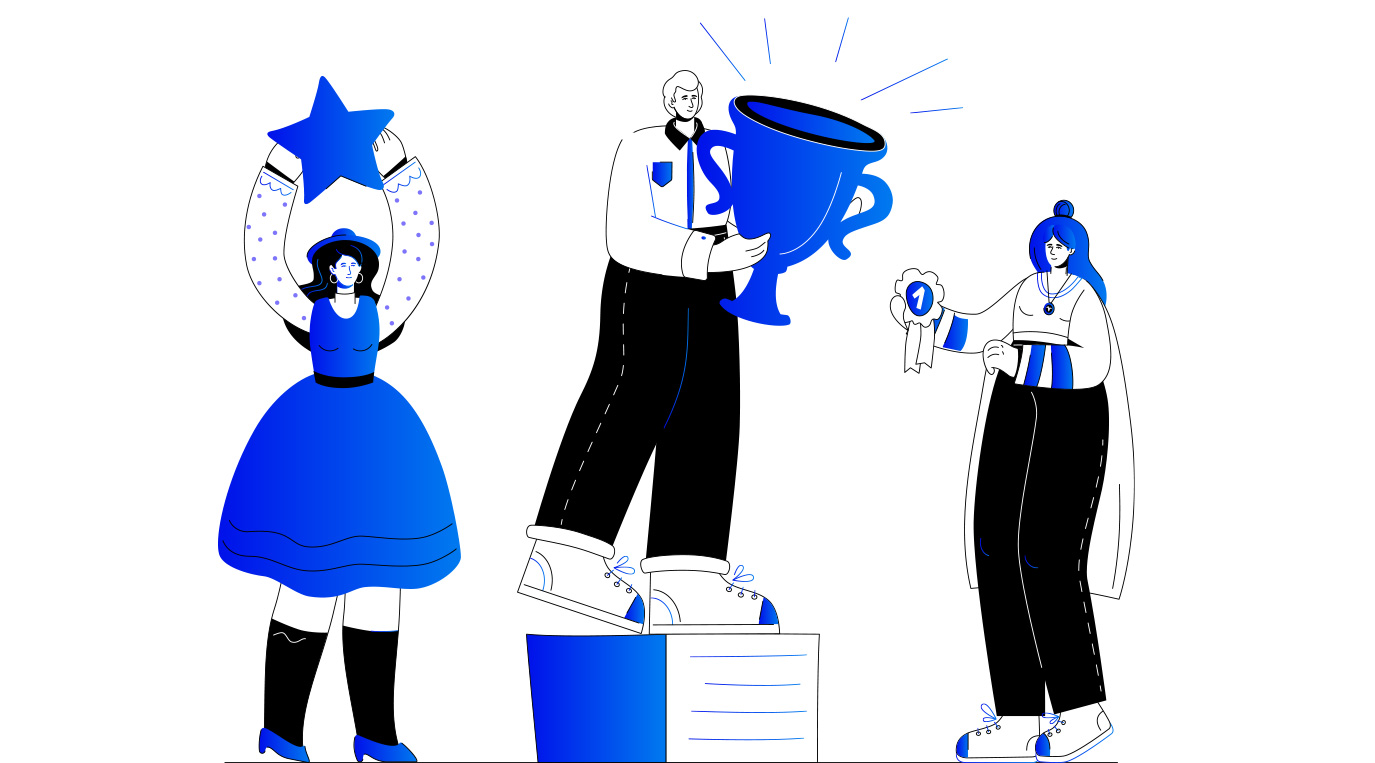
Technology is changing the way brands work. In some areas, this becomes more prominent than others. That is the case for digital ad production, where creative management platforms (CMPs) enable small, in-house teams to produce complex digital campaigns, for multiple markets.
In contrast to banner makers that are limited to the creation stage, a CMP is a single platform that contains the entire campaign workflow – creation, personalisation, distribution, and optimisation.
With powerful scaling tools, CMPs are reducing production time by weeks and removing costly repetitive tasks. They help make one-to-one personalisation campaigns possible, and offer advanced features such as dynamic creative optimisation (DCO). By freeing more time for designers, a creativity boost might very well be the outcome.
To determine the result of that, a creative management platform will provide you with real-time performance data. Features such as updating live campaigns and A/B testing makes it easy to optimise at ad level, based on insights.
Or, produce brand new creatives that can easily be scheduled or published in just a few clicks. CMPs are format agnostic, encompassing ad formats as varied as digital out-of-home (DOOH), social, and video.
All in all, creative management platforms give in-house teams the ability to produce and control omnichannel campaigns with full transparency, as well as optimising on-site advertising, too.
What is the future of in-house marketing?

It is clear that the shift to in-house is happening. Not overnight, but it is happening. As marketing guru Mark Ritson writes, “big clients, the 20% of advertisers who pay for 70% of the world’s advertising, will use their scale and size to bring their buying in-house”. Historically, where they go, the rest follow. We can assume this goes for in-housing marketing, too.
At the same time, whether or not your company will move marketing in-house, is a choice. It will depend on factors such as the size of your business, budget, and what market you are in. Also, how agencies and brand’s work together is changing. More agile ways of working together allows more flexibility. In-housing or not in-housing doesn’t have to be a black or white decision.
No matter the structure, key components to succeed with in-house marketing will be having the knowledge and the technology. Current technologies such as a creative management platform will make it that much simpler to in-house digital advertising. By complementing that with new technologies that are being developed, such as for in-house media buying, you will always be at the forefront both technology and knowledge wise.
The bottom line is – the in-house revolution is here to stay.
